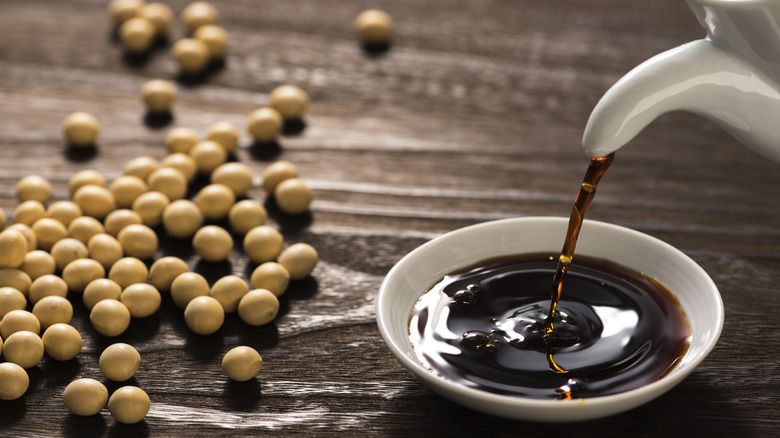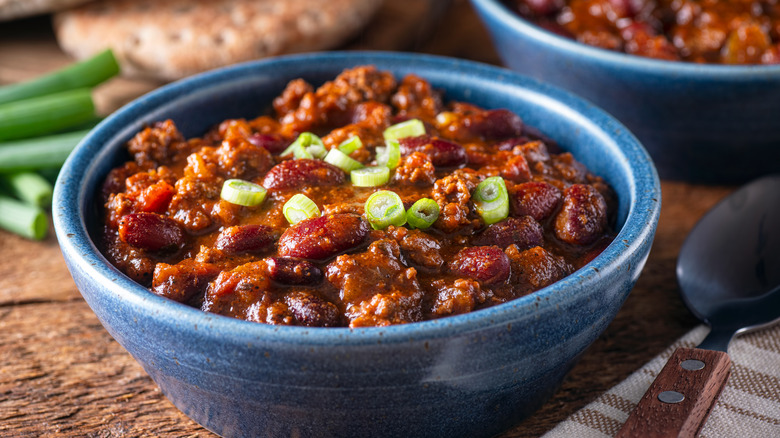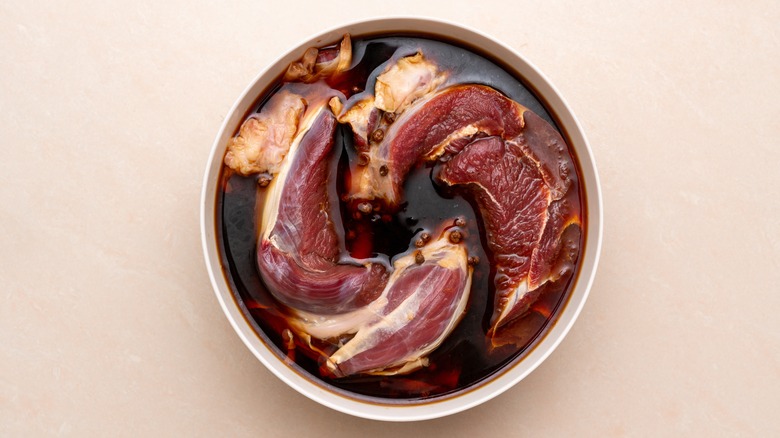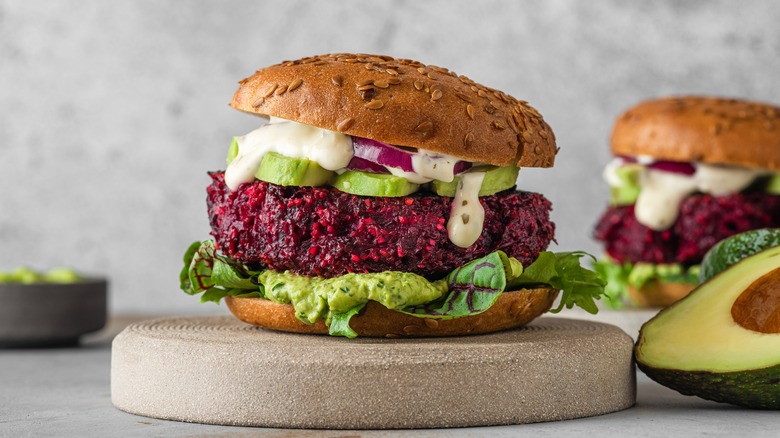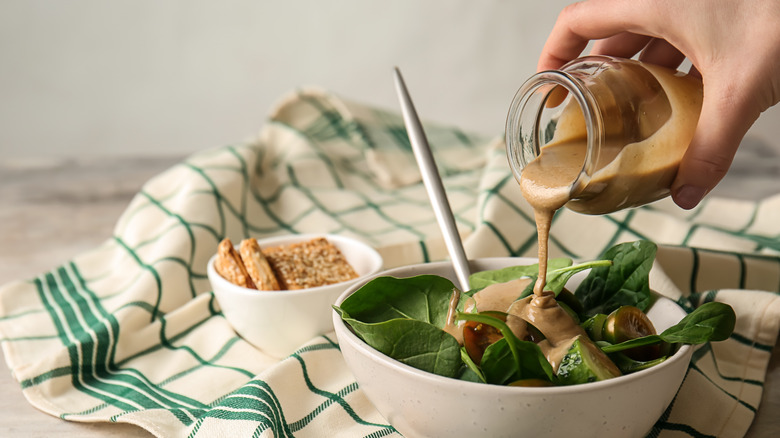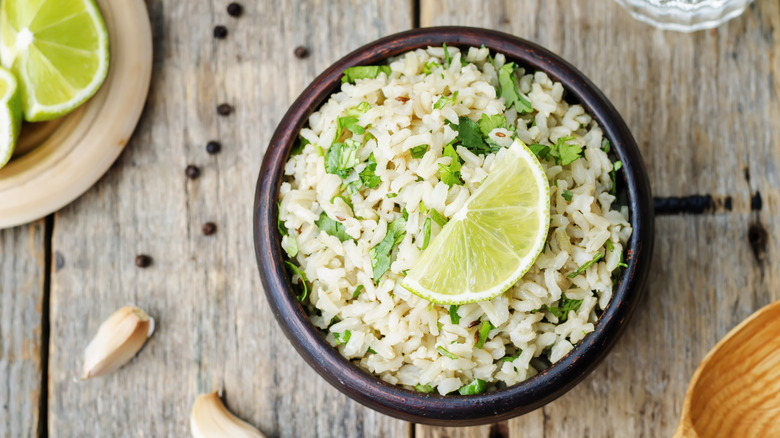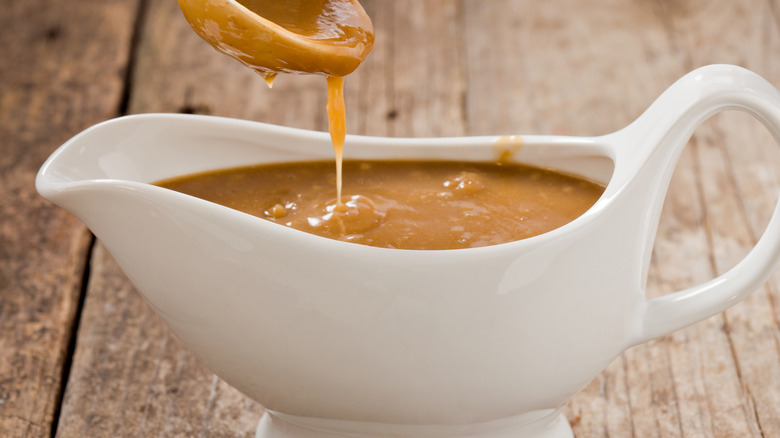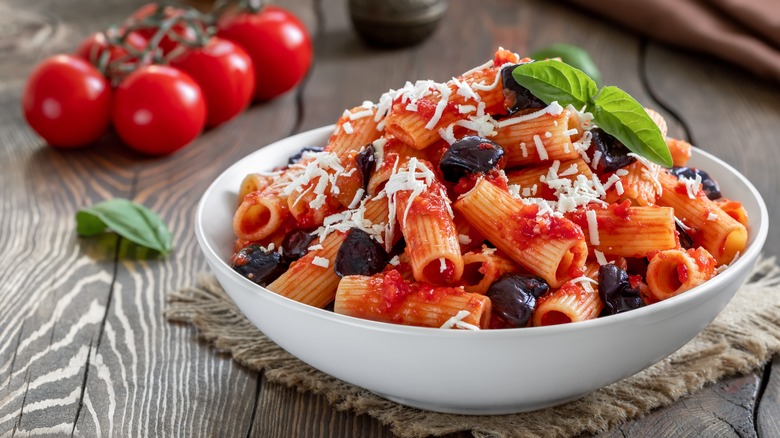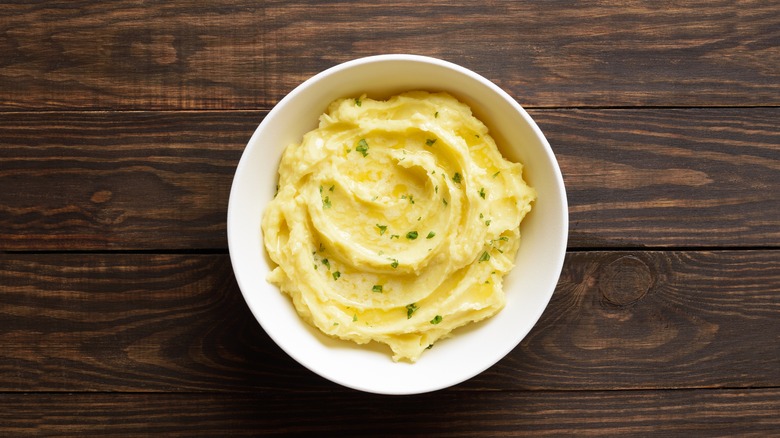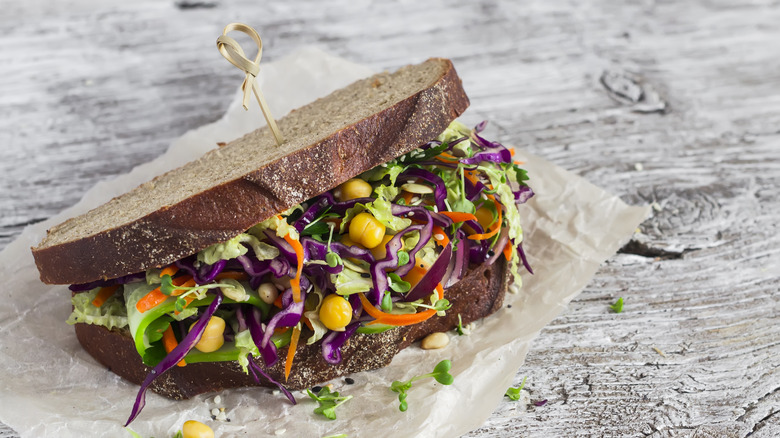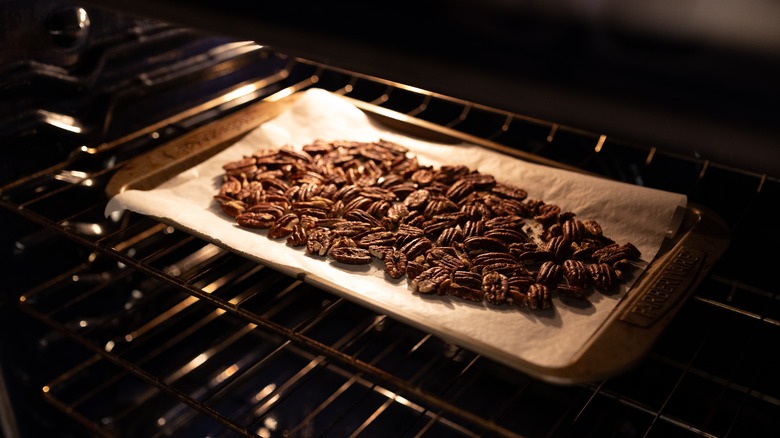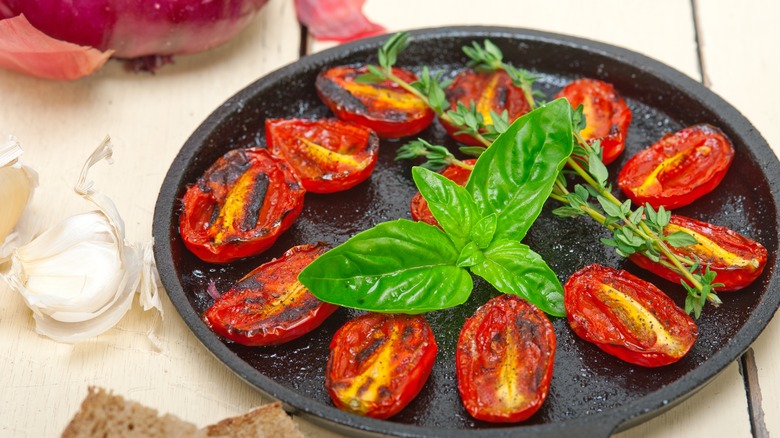14 Ways To Enhance Your Favorite Recipes With Tamari
When you start getting past grilled cheese and buttered pasta, you're bound to stumble upon a few ingredients you've never heard of. What do you use chia seeds for? Why would I sprinkle nutritional yeast on broccoli? And what the heck is tamari?! Tamari is the Japanese soy sauce you should know about. Gluten-free folks might already have an idea about this salty sauce, but for those of you who aren't familiar with it, tamari is a version of soy sauce made without wheat, which is the primary difference between the two. This version of soy sauce is quickly gaining traction as more people have trouble with gluten. And unlike many gluten alternatives, it tastes just as good as its gluten-loaded cousin.
Similar to soy sauce, tamari has a subtle umami flavor with boldly salty tones. Many describe it as having balanced sweet and bitter undertones, and it is primarily used in Japanese cuisine. However, it has so much more range and can be used in everyday cooking and in a variety of cultural cuisines. It is a wonderfully salty ingredient that can add depth to a dish but can also be used as a garnish or dipping sauce. Its versatility allows it to be used in both a salty and sweet capacity. If you're new to the sauce, it's time you grabbed a bottle and started enhancing your favorite recipes with tamari.
Splash tamari in your chili or soup
As we know, adding water to soup can dilute the flavor, which is why broth usually takes its place in many recipes. If you don't have broth on hand, a great alternative is to use water with a splash of tamari. This will help mimic both the saltiness and umami flavor of broth. Alternatively, use broth and then season your soup or chili with tamari instead, or in addition to salt. Oftentimes, when a dish tastes like it's missing something, it's in one of the salt, sweet, acid, or fat departments, and it's easy to tell when a recipe is lacking in saltiness.
There's nothing worse than flavorless soup so use this tip to elevate your next batch of chili. This works especially well for a vegetarian chili or soup because umami is the flavor that is described as meaty or savory. Shiitake mushrooms, cooked tomatoes, miso, and tamari are all plant-based options that hold that rich umami that makes dishes so mouthwateringly irresistible.
Use it in a marinade for grilling
Salt. Salt. Salt. There's a lot to know about salt, but when it comes to marinades, it's essential for its meat tenderizing abilities. Texture is a huge factor in what makes meat so darn delicious. Unless you hunt your own, you've probably never tasted chicken without salt because it's used in the packing process to help with preservation and flavor. This is true for many kinds of meat. Although it's easy to slap your sirloin on the grill without much prep work, it's so much better when it's had a chance to marinade overnight. Tamari is an incredible ingredient that brings out the deep flavors of meat while adding sodium and tenderizing it all at the same time.
Yes, you could use salt alongside your herbs, spices, aromatics, and sugars. But why waste the opportunity to use something with more depth of flavor? Try your favorite tenderizing steak marinade recipe, and swap soy sauce for tamari to make it gluten-free. You can also add tamari to a pre-made marinade. Make a simple vegetable marinade for the grill by mixing olive oil and tamari. It can't get any easier than that.
Mix tamari into your veggie burger recipe
Although the goal of a veggie burger isn't necessarily to taste like a meat burger, it's always nice to mimic some of its qualities. After all, it is still called a "burger." It can be difficult to get the texture just right, but adding a splash of tamari can help bring out the umami flavor associated with meat. It's also a fantastic way to add a little moisture for blending without relying on water. Tarmari is incredibly salty, so be sure to just use a small amount. It's also important not to overdo it because too much moisture can turn a veggie patty into mush and make it very difficult to keep its form.
Because you should only use a small amount, it shouldn't change the coloring of your patty. But if you're worried, use it in a hearty black bean burger instead of one with a chickpea base. Because it's a liquid, use dry ingredients like chickpea flour, oats, and flaxseed to soak some of that moisture up.
Add it to your scrambled or fried eggs
Let's face it, eggs for breakfast can be rather basic and get a bit repetitive. Sure, you can scramble them, fry them, frittata them, or even enjoy them over-easy. The addition of meats and vegetables can make a difference, but it's also important to flavor the eggs themselves. Like any other savory food, they taste better with a salty addition. Egg yolks have an umami flavor to begin with, so adding tamari can only help to elevate those natural flavors.
Adding tamari can help bring life to or recreate your basic scrambled eggs. It's the secret ingredient to elevate eggs. Whip it right into your scrambled eggs, or splash it on your fried eggs the second they hit the pan. In fact, your seasonings, especially herbs and spices, should cook alongside your eggs. This helps to release the aromatic component and brings out the flavors.
Use tamari in salad dressings
Tamari is an incredible salad dressing ingredient but typically only gets used in an Asian-style vinaigrette or dressing. It can be used in almost any style, including balsamic-based dressings as well as creamy dressings. In fact, tamari and balsamic both have rich, deep, strong flavors that are quite compatible. Use them together with olive oil to make a basic, simple dressing or marinade. Be sure to use just a splash of tamari, and let the overpowering ingredients be extra virgin olive oil and balsamic vinegar. This also works well with flavored vinegar.
If you plan to season a creamy dressing with a splash of tamari, keep in mind that it might alter the coloring of the sauce. However, it will be well worth it. Salt simply brings out the flavor of a food, while tamari brings layers of flavor to the table. Next time you're whipping up some homemade dressing, try using tamari in place of salt.
Season your grains
There is nothing worse than plain white rice. It's bland, boring, and seems to dilute all that it comes in contact with. Just like any other grain, rice deserves seasoning. Have you ever noticed that even a little bit of butter or olive oil can go a long way? The goal is to add a little fat, something sweet (just a small dash), something salty, and something acidic, like rice vinegar. There are plenty of simple rice seasonings out there. But sometimes, just a little bit of tamari will do.
Because it's in liquid form, unlike salt, it will distribute evenly throughout the rice and can be used as a seasoning after it is cooked. If you find the change in coloring unappealing, then use it exclusively with brown or wild rice. Splash it into the cooking water, or use it as an afterthought. Either way, you'll be giving the popular grain the flavor it deserves.
Mix it into gravy
The best word to describe a well-made gravy is "rich." Richness gives those mashed potatoes or turkey breast a comforting warmth that lingers on the tongue. We are always looking for opportunities to add more savory flavor to the popular sauce, and one way to do this is by adding tamari. This boost of umami will bring your Thanksgiving dinner to a whole other level. It's a great tip for making brown gravy but can be used in gravies from across cultures.
It's an especially good ingredient to include in a plant-based gravy alongside vegetable broth. The combination of tamari, miso, and olive oil will give taste buds the illusion that there is a heaviness that is typically found in meat-heavy dishes. Luckily for the vegetarians in the house, it won't actually taste like meat, but it won't feel like something is missing to the die-hard meat fans either. It's a win-win all around.
Include tamari in tomato sauce
There are so many ways to enhance a good tomato sauce, whether you're going to use it over pasta, on a sandwich, or on a pizza crust. You can even elevate the flavor of jarred tomato sauces and make them taste homemade just by adding an ingredient or two. Herbs, spices, olive oil, and vinegar can bring it to the next level, but the exceptional ingredient you may have never thought to add is tamari. While tamari is traditionally an Asian-style sauce, it pairs seamlessly with both tomatoes and olive oil, so it can be used in many Mediterranean dishes.
Tomatoes, especially tomatoes that have been cooked down, are loaded with rich savory flavors, which are only enhanced by just a splash of soy sauce or tamari. The contrast of the salty umami sauce with the fresh and sweet basil brings complexity to the diner's palette. Simply tone down the salt or salty broth in your recipe, and include a dash of tamari instead. For your jarred sauce that needs a flavor upgrade, consider tamari in moderation.
Add it to your mashed potatoes
It would be difficult to find a more universally loved side dish than mashed potatoes. They're creamy, starchy, smooth, textured, salty, and buttery. You can make them lumpy with garlic or whipped with chives. Use olive oil and vegetable broth to make a vegan version, or load them up with chicken broth and butter. The ingredient that tends not to make an appearance typically in the potato world is tamari. It should, however, be considered.
Consider using a broth of your choosing or milk, olive oil, butter, miso, and tamari to strike the perfect balance of flavor and richness. If you forgo dairy products, then mix in some nutritional yeast. Don't forget to include whipped roasted garlic or freshly chopped chives. Select Yukon gold potatoes for a sweeter, creamier flavor and texture, or do a mix. Leave those skins on for the additional nutrient kick. They will be so decadent that you won't need to cover it in gravy. The tamari and miso will leave your family and friends in awe that the beloved side dish is even capable of an upgrade, but this special ingredient can remain our little secret.
Splash tamari on sandwiches
Every sandwich maker has their own tried and true methods that they consider primo. A few notable ingredients being fresh herbs, vinegar, roasted garlic, cream cheese, and marinated vegetables. Is your mouth watering yet? Well, for those willing to stray from their typical recipe, try splashing your ingredients with a little bit of tamari. This happens frequently in tofu-heavy sandwiches or a simple banh mi sandwich recipe. But the truth of the matter is that tamari has a place and just about any sandwich from an Italian sub to a southern tomato and mayonnaise sandwich.
To enhance the flavor of the ingredients, splash the tamari right onto the fillings. If you're looking to enhance the flavor of the bread or simply add some saltiness to the mix, then splash it directly onto the sandwich bread. This works well for baguettes and heartier flavorful breads. Who needs your basic salt and pepper, when you have rich and flavorful tamari as a sandwich enhancer?
Use it on roasted nuts
Do you make your own roasted nuts? It's one of those foods that just seems easier to buy, but in actuality, making your own can be less expensive and is fairly easy to do. In the end, they can end up tasting better than the store-bought versions, and you can flavor them to your specific preferences.
A simple flavor combination for coating nuts is to mix maple syrup or honey with tamari, and oil. For the best flavor, choose an oil that comes from the nut you are roasting. For example, if you're roasting walnuts, use walnut oil. The sweetness of the syrup or honey, along with the saltiness of the tamari will help your homemade roasted nuts strike a perfect balance. This is one of the best tips for roasting nuts because while salt can cluster and change the texture, tamari creates an even coating every time. If sweet nuts aren't your thing, forgo the syrup or just use enough to balance the flavor without dominating the recipe. Even just a drop can make a difference. Keep your nut-coating sauce light by only using a small amount and tossing the nuts in a bowl. They shouldn't be submerged in liquid before roasting, only slightly coated. Check them frequently because nuts are incredibly easy to burn and don't need to roast long.
Bake tamari into chocolate desserts
While many of us are just getting on board with adding balsamic vinegar to chocolate baked goods, we are here to tell you that there is another unlikely sauce that can help enhance your dessert. You guessed it, tamari! While this savory, sweet combination might sound jarring, it's been done before with shining results. Olive oil cookies, sea salt and caramel, and even hot pepper honey have proved time and time again that the complexity that contrasts brings is usually quite desirable.
It's time to step outside of your comfort zone and give this dessert hack a go. Use in rich, chocolate-baked goods like fudgy brownies or flowerless chocolate tortes. To include tamari in your dessert, replace half the sea salt with tamari. Try a low-sodium tamari for enhanced flavor without all of the sodium. Replacing all of the salt with tamari might alter the flavor too much, so start small, and if it tickles your fancy, then next time, try a little more. Tamari can also be used in a chocolate drizzle and in combination with balsamic vinegar in a chocolate baked good recipe. You can even add a tiny drop to your homemade hot chocolate instead of salt.
Enhance your curry
Curry is such a versatile dish It's typically of Asian origins, although not always, and encompasses an aromatic and sometimes spicy sauce that is thick, and savory. Thai and Indian curry come to mind, as they are quite popular in the United States. Although traditionally, tamari is used in Japanese cooking, it can do a lot to enhance the flavors of curry.
Whether you're using a creamy coconut base or a simple tomato base, tamari can help accentuate those flavors. Curry is known to be quite flavorful, loaded with spices and aromatics. Tarmari will only add to that charm. Because curry often includes a plethora of spices, it doesn't need as much salt as a simple Thanksgiving gravy or a tomato sauce, but it still requires some. Use tamari in moderation in your best curry recipe. You can also use tamari as a topping like you would table salt by splashing it on after it's been cooked and plated. Let's face it: Curry can never have too much flavor, so load it up to the brim.
Brush tamari onto slow-roasted tomatoes
Have you ever experienced the intense flavor of slow-roasted tomatoes? Now, we don't mean the sun-roasted tomatoes at the grocery store or tomatoes that have been grilled or roasted for a few hours. No. We are talking about those eight-hour tomatoes that have been brushed with olive oil, sprinkled with sea salt, and rubbed with garlic. These tomatoes are condensed with flavor, but there is yet another way to add even more. Instead of salt, brush your slow-roasted tomatoes with tamari.
Now, there are many tips out there for slow-roasting tomatoes, but the best advice for a first-timer is to avoid adding anything that could burn early on. Wait until at least hour six before adding balsamic, garlic, and even tamari. You'll be cooking the tomatoes at a low temperature, and you may have to brush them several times with olive oil to keep them from burning. When they are done, the tomatoes should still retain a bit of moisture but be about half the size they went in as essentially. The umami boost from the tamari will make them even more enticing. Can you feel your mouth watering? Who knew they could get even more savory and delicious.
